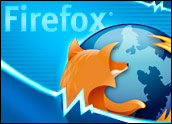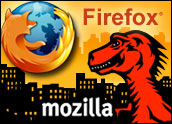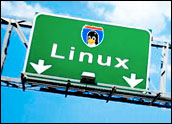
Novell is evangelizing its Suse Linux Enterprise Desktop 10, but the company is not looking for an all-out war with software giant Microsoft. Rather, it is looking to find its niche on the business user’s desktop. Novell has already gained Linux desktop momentum with transaction and fixed-function applications.
The company has high hopes for much greater penetration in the years ahead. Will its desktop dreams come true? Or will Microsoft squash the concept with Vista and its next generation of Office?
One thing is certain. There is an open source revolution taking place in the technology industry — and Microsoft is taking notice. Companies like Red Hat are getting bigger, browsers like Firefox are getting friendlier and security issues are getting tackled. Open source may not take over the technology world, but it has certainly changed it. Novell hopes to ride the wave with its desktop product.
LinuxInsider caught up with Roger Levy, Novell vice president and general manager of open platform solutions, to discuss the company’s open source strategy, the challenges, obstacles and opportunities it faces, and the future of Linux on the desktop.
LinuxInsider: You recently launched Suse Linux Enterprise Desktop 10, which seems to expand the potential targets from transactional desktops to corporate business users. Who are you aiming at with this new version?
Roger Levy: It’s truly suited for the basic business user. That’s a user who relies on e-mail, instant messaging, Web browsing and a core office productivity suite for most of his or her day-to-day tasks. We’re aiming this desktop at businesses who want to expand their Linux footprint, and to businesses who may be using Linux already for transactions or Web infrastructure, but who want to deploy a Linux solution that can serve the general communication and productivity needs of their basic desktop users.
LinuxInsider: Red Hat has focused most of its efforts on Linux server distributions, yet Novell is going head to head with Microsoft on the desktop. Do you believe Linux on the desktop can really compete with Microsoft Windows? If so, what makes you believe this is the case?
Levy: It’s not that Novell is targeting Microsoft or going head to head with Redmond. We are delivering a complete Linux solution for business infrastructure, from the desktop to the data center. Beyond that, we understand that the world is heterogeneous, and will remain a mix of open and proprietary for a long time. We will continue to be responsive to all types of customers, all of whom have made significant investments in proprietary solutions. So will Linux be the right answer for all businesses? No, probably not. But will it be the right answer for a growing number of businesses who are committed to the open enterprise movement? Absolutely.
LinuxInsider: What are the key advantages to Linux desktops, as you see them?
Levy: When compared to existing proprietary desktops, Linux desktops are low-cost alternatives that offer superior security and reliability. Because Linux is inherently more flexible than Windows, it’s easier to configure a Linux desktop that delivers only those capabilities needed to meet specific user requirements. This means that Linux desktops can run more efficiently, because they can be deployed without all the latest resource-eating features of a standard proprietary desktop.
From a management perspective, Linux desktops like Suse Linux Enterprise Desktop 10 from Novell share the same Linux kernel, core Linux services and management infrastructure as the Linux servers that businesses are deploying in ever-increasing numbers. This means that the Linux desktop is easily integrated into a corporation’s overall Linux implementation, saving time and resources while leveraging the same set of IT skills.
Finally, but by no means least important, the Linux desktop benefits from the incredible speed of innovation that is a hallmark of the open source community. Technologies like desktop search, animated user interface effects, and others, are being rapidly extended by open source engineers around the world. As a result, instead of being limited to proprietary platform improvements that are rolled out once or twice a decade, Linux desktop users and Linux users in general enjoy much more frequent updates and much more comprehensive improvements.
LinuxInsider: What is being done to make Linux more comfortable for users in the areas of usability, rapid start-up and easy application installation and updating?
Levy: To create Suse Linux Enterprise Desktop 10, Novell implemented a “design first” methodology, where every major facet of the desktop was subjected to rigorous usability testing. The results of this work have been amazing. Suse Linux Enterprise Desktop 10 includes thousands of design adjustments and improvements made as a result of this testing.
LinuxInsider: What do you see as the biggest adoption hurdles for Linux on the desktop?
Levy: Obviously, the large market share disparity between Windows and all other desktops creates a market momentum that is difficult to overcome. Large scale adoption of Linux, particularly within established economies, is still a long-term prospect. Today, companies are choosing Linux tactically, for specific projects and for specific applications. That is not to say that widespread adoption will never happen. Far from it. But widespread adoption will happen gradually.
Applications will drive desktop adoption for some time, especially in smaller businesses, where there is generally less desktop specialization. I believe that the applications will come to the market, but they may appear in offshore markets first. Let’s face it. The established status quo in North America and EMEA will take longer to change than an emerging market. It’s likely that Linux adoption in the emerging geographies will be the thing that spurs the development of needed applications.
LinuxInsider: Consumers are ultra-sensitive about security. Where does security fit into the Linux on the desktop equation? What is being done to alleviate those fears?
Levy: Security is an important consideration for any business computing initiative. The Linux desktop is a very secure environment. Of course, the Linux operating system is also quite secure, for it has a strong UNIX heritage, and it has been in development for more than 10 years. Yes, there’s a raging debate about whether open source code is “more secure” or “less secure,” and naturally, at Novell, we believe it’s much more secure. But no matter where you stand in that debate, it’s clear that the open source community is very responsive to any security issues that do come up.
To better meet the needs of business users, Novell has contributed an extra layer of security with its Suse Linux Enterprise Desktop 10 release. We are providing AppArmor, an open source project that has been integrated into the Suse Linux Enterprise Desktop. AppArmor delivers a unique profile-based security to Linux systems (including server and desktops) that provides businesses with very granular control over what their deployed systems can and cannot do.
LinuxInsider: What about compatibility issues with Microsoft? Novell has narrowed the gap, but it is not completely closed. What will you focus on next in that regard?
Levy: I think the next steps for interoperability will be a growing need for tools that make it easier for users to migrate from Windows to Linux. Most businesses have specialized applications that they will need to see on Linux before they can totally switch to an open platform. You will see Novell stay active in helping to drive these requirements and solutions.
LinuxInsider: Most people run to Windows by default, or even Macintosh. How will the Linux on the desktop community raise awareness for this option?
Levy: Interestingly, across colleges and universities, there is already a very strong shift to Linux. The community distributions are very good, they’re free, and the whole open source development process, with its peer review and meritocracy, is very compatible with how academic communities run.
There are many communities involved in delivering the next generation of Linux desktop options. There is so much passion for Linux, our community members are our greatest evangelists. At the Novell-sponsored openSuse project, for example, there are more than 25,000 registered members, and Suse Linux, Novell’s community distribution, is installed more than 7,500 times every day.
As commercial distributions like Suse Linux Enterprise Desktop 10 come out, they will rapidly gain favor with users, especially international users. They provide a level of usability and productivity not previously available on Linux. There are millions of evangelists today, waiting to be mobilized.
LinuxInsider: How have open source browsers like Firefox and Opera helped the cause of Linux on the desktop?
Levy: There’s no question that the success of the Firefox browser has helped to accelerate interest in Linux desktops in general. Firefox and, to a degree, Opera, have helped users understand that there is business-class software available that has been created in the open source community. Another open source project that falls into this category is OpenOffice.org. Business users can migrate to these open source tools without needing to upgrade their current operating system. They just replace Microsoft Office with OpenOffice.org, and Internet Explorer with Firefox. This is a great first step for organizations looking to get serious about open source solutions.
LinuxInsider: What do you see as some emerging trends around putting Linux on the desktop?
Levy: For years, companies have been evolving desktop strategies which feature more and more specialized deployment patterns. This is good news for the Linux desktop.
Initially, many businesses are choosing to deploy Linux desktops for transactional or fixed-function implementations. This is an ideal use for Linux desktops. It takes full advantage of Linux’s reliability and security, while leveraging the unique capabilities of Linux to be deployed with just the needed features. In these cases, the Linux desktops are functioning as extensions of a back-office application, and they are typically managed by the server or application group.
But a growing number of companies are also deploying Linux for general business users. These companies are finding that Suse Linux Enterprise Desktop delivers a new standard of usability, productivity and interoperability that equates to a great return on investment for desktop users. Often these companies embark on a phased approach to deploying Linux. First, open source alternatives to core applications — like OpenOffice.org or the Firefox Web browser — are deployed across all Windows desktops. Then targeted groups of users are migrated to Linux. By moving first to open source, and then to Linux desktops, the overall transition to Linux is much more efficient.
LinuxInsider: When do you expect to see Linux on the desktop become more mainstream? What is it going to take to get it there?
Levy: Well, that depends on your definition of mainstream. Arguably, for transactional and fixed-function applications, Linux is mainstream today. For general office workers, Suse Linux Enterprise Desktop will accelerate the deployment of Linux to knowledge workers. Over the next few years, companies who are taking advantage of Linux in their data center or to host corporate applications will start to deploy Linux desktops aggressively. This trend will be most prevalent outside of North America.
With Suse Linux Enterprise Desktop, we believe that there is finally a Linux desktop that is ready to meet the needs of the basic knowledge worker. To go to the next level? Time. We are seeing more users turn to Linux every day and there’s every indication that trend will continue.




















































